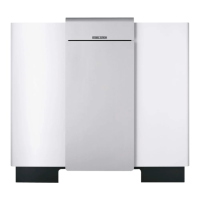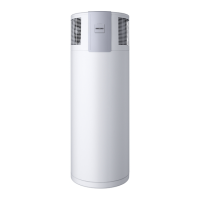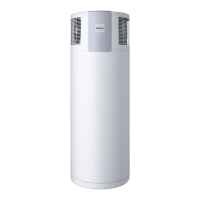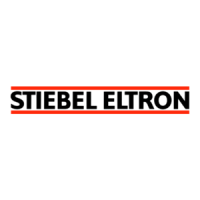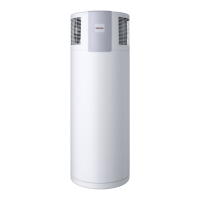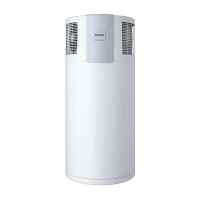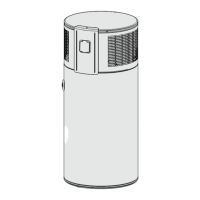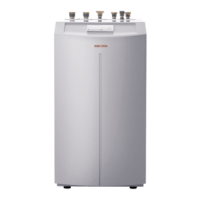www.stiebel-eltron.com WWS 20 | 53
ENGLISH
INSTALLATION
Installation
Thermal insulation
Insulate the DHW line against heat loss in accordance with
locally applicable regulations.
DHW circulation
The heat losses incurred in the DHW circulation line and the elec-
trical power consumption of the circulation pump reduce the effi-
ciency of the system. The cooled water in the DHW circulation line
mixes with the cylinder content. Avoid installing a DHW circulation
line. Where that is not possible, the DHW circulation pump must
be controlled thermally or by time switch.
Gravity brake
To prevent thermal DHW circulation, you should install a gravity
brake between the appliance and the DHW cylinder, depending
on your hydraulic connection (see chapter "Connection to the DHW
cylinder").
Water treatment and application limits
Depending on water temperature and hardness, the following
water treatments should be carried out according to DIN 1988-
200:2012-05:
dH [°]
DHW temperature <60°C DHW temperature > 60°C
0-8.4
(soft)
No water treatment necessary
Periodic descaling recommended
(see chapter "Descaling the ap-
pliance")
8.4-14
(medium)
No water treatment necessary Periodic descaling necessary (see
chapter “Descaling the appliance”)
14-21
(hard)
Periodic descaling necessary
(see chapter "Descaling the
appliance")
Softening
>21 Softening Use is not recommended
Reduce the DHW temperature
Where water quality fluctuates significantly and the DHW temper-
atures are high (>60°C), we recommend annual inspection by a
qualified contractor.
Water constituent
Concentration
(mg/l or ppm)
Time limits
Investigation time
following sampling
Alkalinity (HCO
3
-
)
<70
70-300
>300
0
+
0
within 24h
Sulphate
[1]
(SO
4
2-
)
<100
<200
>200
+
0
-
No limit
HCO
3
-/SO
4
2-
>1.0
<1.0
+
-
No limit
Electrical conductivity
<10µS/cm
10-500µS/cm
>500µS/cm
0
+
0
No limit
pH
[2]
<7.0
7.0-9.0
>9.0
0
+
0
within 24h
Ammonium (NH
4
+
)
<2
2-20
>20
+
0
-
within 24h
Chloride (Cl)
<100
100-200
>200
+
0
-
No limit
Free chlorine (Cl
2
)
<1
1-5
>5
+
0
-
within 5h
Hydrogen sulphide (H
2
S) <0.05
>0.05
+
-
No limit
Water constituent
Concentration
(mg/l or ppm)
Time limits
Investigation time
following sampling
Free (aggressive)
carbon dioxide (CO
2
)
<5
5-20
>20
+
0
-
No limit
Total hardness (°dH) 4-14 No limit (see chapter
"Water treatment")
Nitrate
[1]
<100
>100
+
0
No limit
Iron
[3]
(Fe) <0.2
>0.2
+
0
No limit
Aluminium (Al) <0.2
>0.2
+
0
No limit
Manganese
[3]
(Mn) <0.1
>0.1
+
0
No limit
+ Resistance under normal conditions
0 Corrosion may occur, especially if other factors are rated as 0
- Use is not recommended
[1] Sulphates and nitrates act as inhibitors of pitting corrosion
caused by chloride in pH-neutral environments
[2] Generally, a low pH value (below6) increases the risk of
corrosion. A high pH value (above7.5) reduces the risk of
corrosion.
[3] Fe
3
+
and Mn
4
+
are strong oxidising agents and can increase
the risk of local corrosion in stainless steel.
SiO
2
above 150ppm increases the risk of scale build-up
!
Material losses
To prevent damage to the plate heat exchanger, ensure
that the water is free from contamination (e.g. sludge,
sediment).
If necessary, install a filter in the cold water supply
line.
10.3.1 Connection to the DHW cylinder
You have various options for connecting the appliance to your
DHW cylinder.
Note
Observe the information and limitations in the chapter
"Specification/ Hydraulic connection diagram".
Note
To determine the maximum length of the connection line
between the appliance and DHW cylinder, it may be nec-
essary to subtract higher pressure drop values from the
residual head of the internal circulation pump, subject to
the type of hydraulic connections employed.
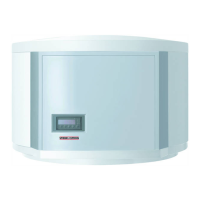
